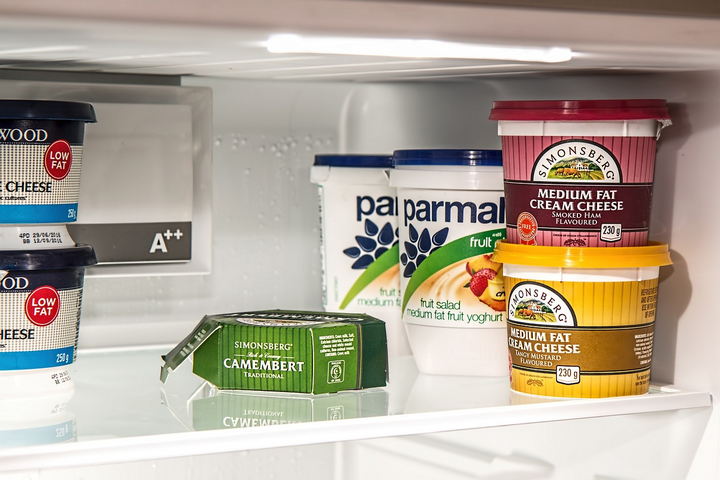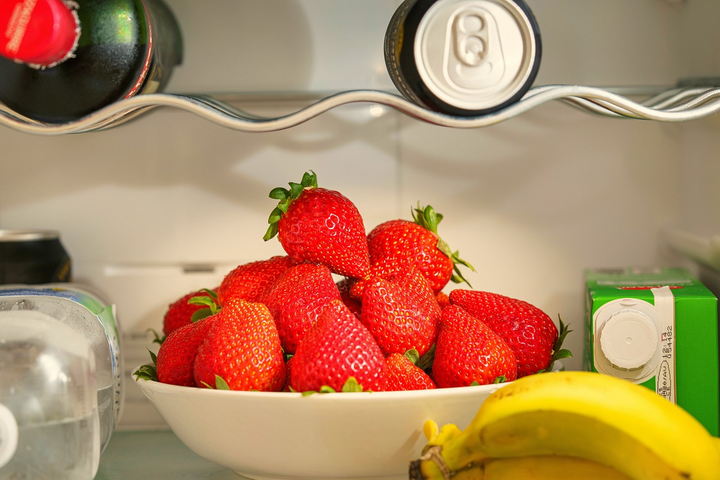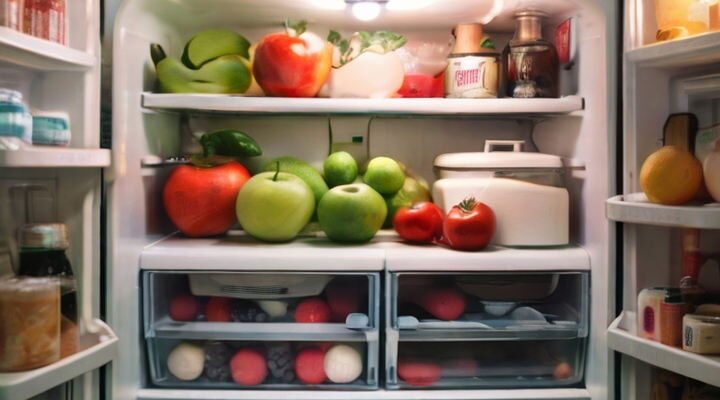Opening your fridge to find a wilting salad that was once a vibrant mix of lettuce and veggies is a common kitchen tragedy. It’s the kind of sight that can turn a well-meaning attempt at healthy eating into a disheartening moment. But, fret not! Optimizing your fridge for longer-lasting produce is not only doable; it’s easier than you think. With a few strategic moves, you can keep your fruits and veggies fresh, delicious, and ready-to-eat for much longer.
For example, a crisper drawer. Are you using it correctly? This special fridge feature is not just a bottom bin to chuck all your greens into. No, it’s a humidity-controlled sanctuary designed to keep your leafy friends and other veggies in peak condition. Using crisper drawers effectively means adjusting settings to suit the humidity needs of different produce types.
And what about those times when your eyes are bigger than your stomach at the farmer’s market? Freezing produce is a fantastic way to extend its life. But there’s a method to the madness. From blanching certain veggies to storing fruits in airtight containers, freezing can be your secret weapon against food waste. Plus, it ensures you always have a stock of healthy options at your fingertips.
Prepping your veggies right after shopping can also encourage you to use them before they go bad. Washing, cutting, and storing your veggies in visible, accessible containers can make healthy snacking easier and more appealing.
So, say goodbye to the days of discovering a forgotten cucumber that’s turned into a slimy science experiment in the back of your fridge. With these strategies, you’re on your way to a waste-free, produce-rich kitchen. Stay tuned as we peel back the layers on keeping your fruits and veggies vibrant and vital, ensuring every meal is as fresh as possible.
10 – Temperature and Humidity Mastery
Keeping your fridge at the ideal temperature isn’t just about following rules; it’s about creating an environment where your produce can thrive. The USDA recommends keeping your fridge at a cool 35-40°F to slow down the growth of bacteria and keep your food safe. However, it’s not just about safety; it’s also about maintaining the freshness and nutritional value of your fruits and vegetables. A fridge that’s too cold can damage sensitive items like lettuce, turning them limp and unappetizing, while a fridge that’s too warm can speed up the spoilage process.
Humidity plays a crucial role, too. Most refrigerators come with crisper drawers designed to maintain a higher humidity level than the rest of the fridge, which is essential for leafy greens and certain other vegetables. Using these drawers correctly can extend the life of your produce by days or even weeks. It’s a simple step that makes a big difference, reducing food waste and keeping your fruits and veggies tasting fresh for longer. Adjusting the humidity settings according to what you’re storing—high humidity for leafy greens and low for fruits and veggies that emit ethylene—can prevent premature spoilage.
09 – The Ethylene Effect
Ethylene gas is like the invisible hand that speeds up the ripening process of many fruits and vegetables. Some produce, like apples, bananas, and avocados, emit high levels of ethylene, which can have a domino effect on the rest of your produce, causing everything to ripen—and then spoil—much faster than you’d like. Understanding which items produce ethylene and which are sensitive to it is crucial for organizing your fridge.
To combat the ethylene effect, store ethylene-producing items separately from ethylene-sensitive items. For example, keep apples and bananas in one part of the fridge and your leafy greens in another, preferably in the crisper drawer where they’re less likely to be affected. This separation can drastically extend the shelf life of your produce, ensuring that your veggies stay crisp and your fruits stay juicy until you’re ready to enjoy them.
08 – Crisper Drawer Chronicles
Crisper drawers are not just random bins at the bottom of your fridge; they’re scientifically designed to extend the life of your produce. These drawers maintain a higher humidity level than the rest of the fridge, which is a game-changer for leafy greens and herbs that tend to wilt quickly. By understanding and utilizing these drawers’ settings, you can create the perfect microenvironment for each type of produce you’re storing.
However, not all fruits and veggies require the same level of humidity. Some, like oranges and apples, prefer a lower humidity environment that mimics the drier air of your kitchen, while others, like kale and carrots, thrive in the moist environment of a high-humidity drawer. Experimenting with your crisper settings and organizing your produce accordingly can make a noticeable difference in their lifespan and taste.

07 – The Art of Placement
The location of your produce within the fridge can affect its longevity and flavor. The back of the fridge tends to be the coldest area, making it ideal for storing perishable items like dairy and raw meat, but not all produce benefits from being in the coldest spot. For instance, storing leafy greens in the middle or lower shelves, where the temperature is consistent but not too cold, can prevent them from freezing and wilting.
Moreover, the door of the fridge is the warmest part, making it less ideal for perishables but perfect for condiments and drinks. Fruits and vegetables, however, should find a home in the main compartment or crisper drawers, where temperature and humidity can be better controlled to suit their needs. Proper placement ensures that each item stays at its peak for as long as possible, reducing waste and keeping everything delicious.
06 – Freezer Friendly Produce
Freezing is a powerful tool in your arsenal against food waste. It can significantly extend the life of your produce while maintaining nutritional value. Not everything freezes well, though, so knowing what works can save you from disappointment. Fruits like berries, peaches, and mangoes are great candidates for the freezer and can be used later for smoothies or baking. Vegetables often need a quick blanch before freezing to preserve their texture and color.
The key to successful freezing is proper packaging. Air is the enemy of frozen produce, leading to freezer burn and loss of flavor. Use airtight containers or freezer bags to wrap your produce tightly, squeezing out as much air as possible. Labeling everything with the date of freezing helps you keep track of what you have and ensures that you use older items first. With a little preparation, you can enjoy the taste of summer fruits and freshly harvested vegetables all year round.
05 – Prepping for Success
The simple act of washing, drying, and cutting your vegetables right after you bring them home can dramatically increase the likelihood that you’ll use them before they go bad. Prepping veggies makes them more convenient to grab and go or toss into recipes without the added time and hassle of preparation when you’re in a rush. This not only saves time but also encourages healthier eating habits by making fruits and vegetables the easy choice for snacks or meal additions.
After prepping, storing your veggies in see-through containers at eye level in your fridge can make a huge difference. Clear containers serve as a constant visual reminder of the fresh food you have on hand, nudging you to consume it before it spoils. This visibility is crucial for maintaining a waste-free kitchen and ensures that your prepped produce doesn’t just stay out of the landfill but also goes towards nourishing your body.
04 – Moisture Management
One of the quickest ways for produce to deteriorate is by getting trapped in excess moisture. That slimy lettuce or those mushy berries are often the result of too much water lingering around. Absorbing excess moisture with paper towels before storing can extend the life of your produce. Placing a paper towel in the bag with leafy greens or around other moisture-sensitive veggies can help absorb condensation, keeping them crisp and fresh for longer.
For certain produce, like mushrooms or herbs, using breathable bags or containers that allow for a bit of airflow can prevent them from becoming damp and spoiled. Plastic bags can often trap moisture, leading to quicker spoilage. Switching to containers or bags with ventilation or opting for materials that naturally wick away moisture can make all the difference in prolonging the shelf life of your fruits and veggies.

03 – Specific Storage Solutions
Knowing how to store tricky items can save a lot of frustration—and food. Avocados, for instance, can be ripened on the counter and then moved to the refrigerator to slow down the ripening process. If you’ve used only half, keeping the pit in and storing the unused portion with a bit of lemon juice can prevent browning. Fresh herbs like oregano or basil can last longer when stored upright in a glass of water, covered loosely with a plastic bag in the fridge.
Another example; mushrooms. These fungi friends prefer a cool, dry place and do best in a paper bag in the fridge, which allows them to breathe and prevents moisture buildup. Unlike most produce, mushrooms can become slimy and discolored if stored in plastic, as it traps moisture around them. This simple switch can keep them fresh and ready for your next meal.
02 – Visibility is Key
It’s a simple truth that we’re more likely to eat what we can see. Storing produce in clear containers at eye level turns your fridge into a showcase of fresh, healthy options. This strategic placement ensures fruits and vegetables are the first thing you see when you open the fridge, making them the easy choice for snacks or meal components. This not only reduces waste but also supports a healthy diet by making fruits and vegetables more accessible.
An organized fridge isn’t just pleasing to the eye; it’s a tool for maintaining a healthy diet. By grouping similar items together and using labels or designated bins, you create an environment where healthy choices are effortless. This organization makes it easier to track what you have, reducing the chance of overbuying and allowing you to quickly identify what needs to be used up soon.
01 – Regular Fridge Audits
Set a regular schedule to go through your fridge and take stock of what’s inside. A weekly fridge audit helps you keep track of expiration dates, use up produce that’s nearing its end, and plan your meals around what needs to be consumed first. This habit not only minimizes waste but also aids in meal planning and ensures a rotation of fresh ingredients for your meals.
As part of your fridge management routine, ensure everything has a place and that leftovers and more perishable items are moved to the front. This rotation system makes it less likely for items to be forgotten in the back, turning into unwanted science experiments. By keeping tabs on what you have, you’re more likely to use up all your ingredients, saving money and reducing waste in the process.
Beyond the Fridge: Mastering Counter and Pantry Produce Storage
While the fridge plays a pivotal role in keeping our produce fresh, not all fruits and veggies are cold-storage friendly. In fact, proper pantry and counter storage can significantly extend the freshness of certain produce, ensuring they retain flavor, texture, and nutritional value. Here’s how to ace the art of storing your produce outside the fridge:
Countertop Champions
Some fruits and vegetables thrive in the room-temperature ambiance of your kitchen counter. Embracing this method not only preserves their quality but can also enhance their ripening process. Here are some countertop favorites:
- Tomatoes: Keeping them on the counter helps maintain their flavor and texture.
- Bananas: Ideal for room temperature until they reach your preferred ripeness.
- Avocados: Speed up the ripening process by placing them on the counter.
- Stone fruits: Peaches, plums, and nectarines ripen beautifully on your countertop.
- Citrus fruits: Oranges, lemons, and limes do well in a cool, dry place.
Pantry Protectors
The pantry or a cool, dark cupboard is another safe haven for certain produce. Here’s what prefers the pantry over the fridge:
- Potatoes: A cool, dark place prevents sprouting and maintains firmness.
- Onions and garlic: Their flavors stay robust and they avoid moisture accumulation.
- Winter squashes: Varieties like butternut and acorn squash last longer in pantry conditions.
- Hardy root vegetables: Carrots and beets stored in a cool, dark place will stay crisp.
Maintaining Moisture and Airflow is crucial for both countertop and pantry storage. Ensure that your produce has enough room to breathe, and for those stored in bags or containers, check that there’s adequate ventilation to prevent premature spoilage.
Ethylene Sensitivity should also be considered. Just like in the fridge, some fruits and veggies are more sensitive to ethylene gas, even at room temperature. Keeping ethylene producers away from sensitive items will help extend their shelf life.
Seasonal Adjustments
Your storage strategies might need to shift with the seasons. Warmer months might require finding the coolest spot in your home to prevent produce from overripening, while in cooler months, some items that normally reside in the pantry might be happy on the counter.
By mastering the art of produce storage beyond the fridge, you’re taking another step towards sustainable living. Reducing waste not only saves money but also respects the resources that went into growing each fruit and vegetable. Remember, every piece of produce has its preferred spot within your home. Finding it can be a fun and rewarding challenge that pays off in flavor and freshness.
A Fresh Ending to Organize Your Fridge
As we wrap up our comprehensive guide to keeping your produce fresher for longer, remember that these tips are more than just instructions; they’re a new way to interact with your kitchen. Implementing these strategies transforms your fridge from a mere appliance into a treasure chest of vibrant, nourishing foods.
Embrace the new norm of fridge organization and enjoy the benefits that come with it—less food waste, more delicious meals, and a healthier lifestyle. Your commitment to proper produce storage reflects a broader dedication to sustainability and mindful living. By optimizing the way we store our fruits and veggies, we’re not just extending their shelf life; we’re honoring the labor that brought them to our tables and the resources used in their cultivation.
The journey doesn’t stop here. Regular fridge audits ensure that your efforts remain effective. Make it a habit to scan your fridge, reorganize when necessary, and keep track of what needs to be used soon. This ongoing process is key to maintaining an organized fridge and minimizing waste. Plus, it’s incredibly satisfying to open your fridge and see everything neatly arranged and easy to find.
Let’s not forget the joy of cooking with fresh ingredients. There’s something profoundly gratifying about preparing a meal with produce that’s been stored perfectly. It’s as if each fruit and vegetable is thanking you for the care you’ve taken by offering the best flavors and nutrients it can provide. This guide isn’t just about storage; it’s about enhancing your entire culinary experience.
In closing, remember that every small step you take towards better produce storage is a leap towards a healthier, more sustainable lifestyle. Share these tips with friends and family, and let’s all make mindful food storage the norm in our kitchens.


